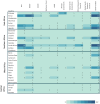Characteristics of longitudinal maternal health studies in sub-Saharan Africa: A systematic mapping of literature between 2012 and 2022
- PMID: 39548805
- PMCID: PMC11911973
- DOI: 10.1002/ijgo.16035
Characteristics of longitudinal maternal health studies in sub-Saharan Africa: A systematic mapping of literature between 2012 and 2022
Abstract
Background: High maternal mortality rates in sub-Saharan Africa necessitate the need for aligned research focusing on prevalent causes and neglected conditions in the region.
Objective: This mapping review aimed to describe the characteristics of longitudinal maternal health studies between 2012 and 2022 in sub-Saharan Africa and identify gaps in priority conditions or geographical locations.
Search strategy: We identified references through a Medline (PubMed) search covering September 2012 to June 2022.
Selection criteria: We included prospective cohort or clinical trials that enrolled at least 1000 pregnant women, with a study site in sub-Saharan Africa, and published in English or French.
Data collection and analysis: Screening and data extraction were done in duplicate using EPPI-reviewer software. Descriptive analysis was used to summarize the results, identifying patterns in studies across time, country, study design, topics, and funders.
Main results: We identified 213 eligible studies, which were covered in 534 publications. We identified studies in 33 of the 48 sub-Saharan African countries, with the majority in east and southern Africa. The predominant study topics were HIV (36.4%), nutrition (20%), and malaria (16.3%), with very few publications on hypertensive disorders of pregnancy (6.4%), ante/postpartum hemorrhage (3.7%), and sexually transmitted infections (3.2%). More studies were cohorts (115/213; 54%) than clinical trials. The National Institutes of Health (31.5%), Bill and Melinda Gates Foundation (22.1%), and USAID (10.8%) were the largest research funders.
Conclusion: Identifying research trends and mismatches between research topics and disease burden provides useful information for guiding future research prioritization. In particular, gaps exist for studies on hypertensive disorders of pregnancy and ante/postpartum hemorrhage, among the top causes of maternal mortality in sub-Saharan Africa.
Keywords: clinical trials; longitudinal studies; maternal health; prospective cohorts; research funding; sub‐Saharan Africa; systematic mapping.
© 2024 The Author(s). International Journal of Gynecology & Obstetrics published by John Wiley & Sons Ltd on behalf of International Federation of Gynecology and Obstetrics.
Conflict of interest statement
The authors have no conflicts of interest.
Figures







Similar articles
-
Systematic review of the magnitude and case fatality ratio for severe maternal morbidity in sub-Saharan Africa between 1995 and 2010.BMC Pregnancy Childbirth. 2011 Sep 28;11:65. doi: 10.1186/1471-2393-11-65. BMC Pregnancy Childbirth. 2011. PMID: 21955698 Free PMC article.
-
Care-seeking for difficulties conceiving in sub-Saharan Africa: findings from population-based surveys in eight geographies.Hum Reprod. 2024 Aug 1;39(8):1712-1723. doi: 10.1093/humrep/deae084. Hum Reprod. 2024. PMID: 38986015 Free PMC article.
-
Mefloquine for preventing malaria in pregnant women.Cochrane Database Syst Rev. 2018 Mar 21;3(3):CD011444. doi: 10.1002/14651858.CD011444.pub2. Cochrane Database Syst Rev. 2018. Update in: Cochrane Database Syst Rev. 2018 Nov 14;11:CD011444. doi: 10.1002/14651858.CD011444.pub3. PMID: 29561063 Free PMC article. Updated.
-
Effect of maternal HIV infection on birth outcomes among HIV positive women in Sub Saharan Africa: a systematic review and meta-analysis.BMC Public Health. 2025 Feb 5;25(1):459. doi: 10.1186/s12889-025-21497-x. BMC Public Health. 2025. PMID: 39910494 Free PMC article.
-
Access barriers to obstetric care at health facilities in sub-Saharan Africa-a systematic review.Syst Rev. 2017 Jun 6;6(1):110. doi: 10.1186/s13643-017-0503-x. Syst Rev. 2017. PMID: 28587676 Free PMC article.
References
-
- World Health Organization (WHO) . United Nations Children's fund (UNICEF), United Nations Population Fund (UNFPA), World Bank Group, UNDESA/population division. Trends in Maternal Mortality 2000 to 2020: Estimates by WHO, UNICEF, UNFPA, World Bank Group and UNDESA/Population Division; Geneva: World Health Organization; 2023.
-
- United Nations . Sustainable Development Goals [UN website]. Accessed May 15 2023. https://www.un.org/sustainabledevelopment/health/#:~:text=Goal%203%20tar...
-
- UNICEF . UNICEF data warehouse: Neonatal Mortality Rates [UNICEF website]. Accessed May 20 2023. https://data.unicef.org
-
- Say L, Chou D, Gemmill A, et al. Global causes of maternal death: a WHO systematic analysis. Lancet Glob Health. 2014;2(6):e323‐e333. - PubMed
Publication types
MeSH terms
Grants and funding
LinkOut - more resources
Full Text Sources
Medical

